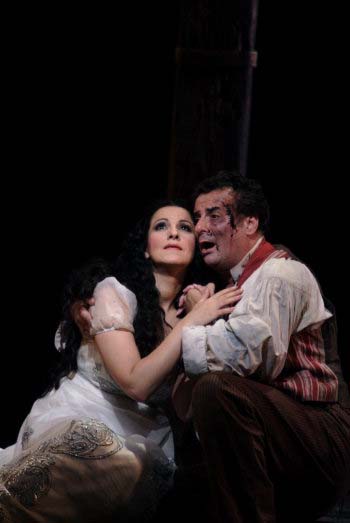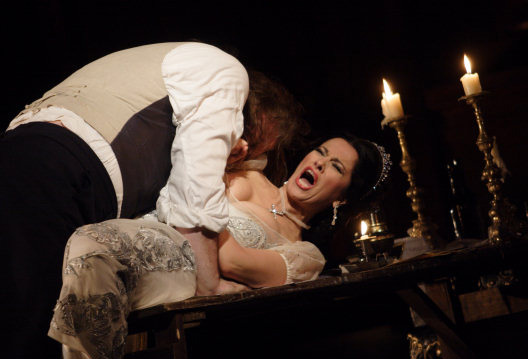Other Links
Editorial Board
-
Editor - Bill Kenny
-
Deputy Editor - Bob Briggs
Founder - Len Mullenger
Google Site Search
SEEN AND HEARD UK OPERA REVIEW
Puccini,
Tosca: Soloists,
Chorus and Orchestra of the Royal Opera House, Covent Garden/Jacques
Lacombe, Royal Opera House, Thursday July 9th, 2009 (CC)
Conductor: Jacques Lacombe
Director: Jonathan Kent
Revival Director: Stephen Barlow
Designs: Paul Brown
Lighting: Mark Henderson
Cast:
Floria Tosca: Angela
Gheorghiu
Mario Cavaradossi: Marcello Giordani
Baron Scarpia: Bryn Terfel
Spoletta: Martyn Hill
Cesare Angelotti:
Kostas Smoriginas
Sacristan: Jeremy White
Sciarrone: Matthew
Hargreaves
Shepherd: Johan de Silva
Gaoler: John Morrissey

Angela
Gheorghiu as Tosca and Marcello
Giordani as Cavaradossi
Even
before curtain-up and baton
down, this Tosca had been firmly in the press due
to the indisposition
of the scheduled Tosca, Deborah Voigt, due to acute colitis. In her
stead, two
Romanian sopranos share top billing, Angela Gheorghiu and Nelly
Miricioiu, and
it was Gheorghiu who stepped onstage for the first night of the run.
Gheorghiu
sang Tosca back in the
2006 run of this staging, sharing the role in that instance with Catherine
Naglestad. Here she sang against the Mario Cavaradossi of the
Sicilian
tenor Marcello Giordani and the astonishing Scarpia of Bryn Terfel. The
staging
is based on Jonathan Kent’s for the 2006 performances (it has been
revised in
each season since then) – the revival director is Stephen Barlow.
The
production is relatively
traditional. A split-level stage provides space for Act 1’s action. The
painting that causes such controversy in the plot is stage right and in
full
view; there is a Madonna in the centre. The main impression of the
first act is
half-light tending towards darkness. Act 2 is enacted in Scarpia’s
apartments
at the Palazzo Farnese, a place where bookshelves either have token
books or
none at all and where the only vaguely full bookshelf opens out as a
door. The
final act is impressive in its nocturnal evocation (points of light for
stars);
Lacombe seemed to take the on-stage night and suffuse the music with
it. The
final act had real momentum and tension, all due to Lacombe’s
long-range
hearing.
Angela
Gheorghiu ‘s assumption of
the title role is impressive. I have been less than impressed by
Gheorghiu in
the past, either live in concert at the Festival Hall (I gave her a mixed
reception in 2005) or in Met/Barbican simulcast (Mimì, Bohème
in April
2008). Yet she did live every second of
the anguished second act.
Only a rather tremulous beginning to “Vissi d’arte” detracted here,
and, as if
aware of this, Gheorghiu brought that section to an impressive climax.
Here
final suicidal exit from the stage was a bit on the careful side, but
then
again I suppose one broken leg at Covent Garden recently is enough …
Marcello
Giordani has previously
sung Cavaradossi at the Puccini Festival in Torre del Lago in 2007. His
is
endowed with a big voice, as his “Dammi i colori … Recondita armonia”
demonstrated – the thought did cross my mind that he is a little too
powerful,
rather lacking subtlety. His final act “E lucevan le stelle” went a
long way to
discredit that statement, and indeed it was in the final act that it
all seemed
to come together for Ghiorghiu and Giordani. I just wish he had a bit
more
power – the defiant cries of “Vittoria” lost their spine-tingling
quality,
alas. Giordani’s future plans include Calaf at the Met and Gustavo (Ballo)
at the Vienna State Opera.

Whatever
the positives of Gheorghiu
and Giordani, it was Terfel who stole the show. Both assumptions of
Tosca and Cavaradossi
had their negative side – not so for this Scarpia. Terfel is physically
perfect
for the role – a great intimidating hulk of maleness. I had seen his
Scarpia on
DVD (Chailly, Decca 074 3201), but it is in the theatre that the full
impact
lies. His voice, of course, matches his wall-like bulk. He positively
dominates
the stage, and lives the role, spitting out his sly cries of “Ah,
Tosca”. There
was real chemistry between Gheorghiu and Terfel (there is a moment when
it can
go either way, when it looks like they might kiss), something which
adds to the
sickly fascination of the second act.
The
Lithuanian bass-baritone Kostas
Smoriginas, a member of the Jette Parker Young Artists Programme, took
Angelotti
(as he did in the 2008 revival), and did so creditably. His voice is
big
enough, certainly. I wish the Spoletta, Martyn Hill, had been creepier
– in the
Chailly Amsterdam performance, John Graham-Hall is just as evil as his
Scarpia,
just in a different, slimier way. John Morrissey’s Gaoler was a fine
assumption
of this small role; the Shepherd Boy of the first night, Johan de
Silva,
similarly acquitted himself well. Jeremy White was a characterful
Sacristan.
Arguably
most impressive of all
was the conducting of Jacques Lacombe (who was kind enough to grant me
an
interview the morning after this performance). He kept things moving,
allowing
the music to generate momentum without ever giving the impression of
rushing.
His ear for orchestration is astonishing. Right from the expertly
balanced
opening chords, this facet of his direction was in evidence. It was as
if
Lacombe was out to discredit the Puccinian nay-sayers who insist this
music is
all splodge. He has a fine sense of the large-scale as well as the
moment-to-moment beauty. Moments of subtlety were many and varied,
complementing the grand effects of the Te Deum, the stabbing of Scarpia
and Cavaradossi’s
execution. There was the odd moment that I am sure will be tidied up in
later
performances – Lacombe was going straight to a rehearsal intended just
for that
after our interview – like the fact that “Vissi d’arte” did not start
together,
but Lacombe is a significant conductor and Covent Garden would do well
to
ensure his services in the near future.
Colin Clarke
Pictures © Catherine Ashmore
